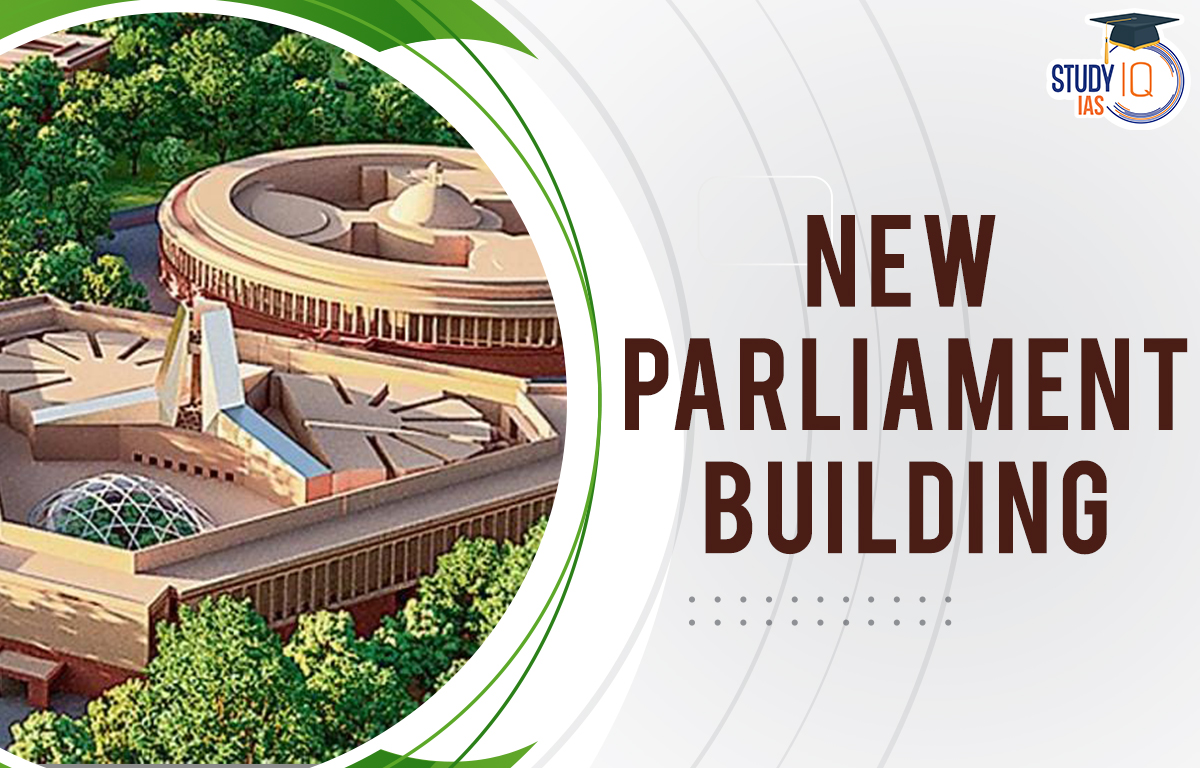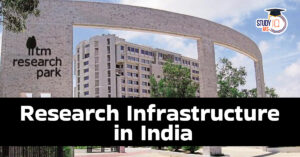Table of Contents
New Parliament Building
As India celebrated its 75th Independence Day, it unveiled its new Parliament building on 28 May 2023, inaugurated by Prime Minister Narendra Modi. This impressive structure reflects India’s growth and culture and is located on Rafi Marg in New Delhi. The new Parliament houses the Rajya Sabha and Lok Sabha, with 888 seats in the Lok Sabha and 384 in the Rajya Sabha. The Lok Sabha hall is inspired by the peacock, while the Rajya Sabha hall features a lotus theme.
Designed to last 150 years and withstand earthquakes, the building covers about 65000 square meters and has a triangular shape for efficient space use. During the inauguration, Modi also installed the Chola Sengol near the Lok Sabha Speaker’s chair, emphasizing the building’s significance in Indian democracy. The New Parliament Building is an important topic to learn about and comes under the polity section of UPSC Subject which an important subject in UPSC Syllabus. Students can also go for UPSC Mock Test to get more accuracy in their preparations.
New Parliament Building Location
The New Parliament Building is part of the Central Vista Project, located from Rashtrapati Bhavan to India Gate. This area includes Rajpath and nearby government buildings. In December 1911, King George V announced that Delhi would become the capital of India during the Delhi Durbar, which celebrated his coronation.
The new city was designed by architects Edwin Lutyens and Herbert Baker, who were inspired by European classic styles. Lutyens also designed Rashtrapati Bhavan, while Baker created the Secretariat, which includes the North and South Blocks. The architecture of the Indian Parliament is modeled after the Chausath Yogini Mandir in Madhya Pradesh.
New Parliament Building Need
The existing Parliament House, opened in 1927, is nearly a century old and has faced increasing demands due to more parliamentary activities. Over time, it has been modified repeatedly, leading to signs of wear and insufficient space, amenities, and technology. Several reasons prompted the need for a new Parliament building:
- Limited Seating: The original building can’t accommodate the growing number of MPs, especially with a planned increase in Lok Sabha seats after 2026.
- Deteriorating Infrastructure: Additions like water and air systems have caused water damage, affecting both aesthetics and safety.
- Outdated Technology: The communication systems are old, and the acoustics need improvement.
- Safety Issues: The building’s design is outdated for today’s seismic risks, as Delhi’s safety classification has changed from Zone II to Zone IV.
- Crowded Workspaces: To fit more staff, workspaces have been divided, reducing overall efficiency.
The new Parliament building will stand next to the old one and aims to represent the aspirations of India’s 1.35 billion people. Together, both buildings will enhance the efficiency of parliamentary operations.
New Parliament Building Design & Features
The new Parliament building will feature the national anthem, traditional carpeting, and fresco paintings like those in Rashtrapati Bhawan. To keep some elements of the old Parliament, shlokas will be written on the walls. The main materials will be Dholpur stone, with red granite used in some interior areas. Construction will be carefully managed to protect the environment.
The new Lok Sabha will seat 888 members, up from the current 543. The Rajya Sabha will have 384 seats, an increase from 245. When both houses meet together, there will be space for 1272 members, compared to the 430 seats available now. This expansion is in preparation for a larger Parliament, as the freeze on the distribution of seats will end in 2026.
New Parliament Building Major Attraction
The Major attractions in The New Parliament are briefed below:
- The new Parliament building will have six entrances featuring statues of “auspicious animals,” chosen for their cultural significance and traits like intelligence, victory, and prosperity.
- Each animal represents positive qualities to promote harmony and well-being in the space.
- The northern entrance will have a gaja (elephant), symbolizing knowledge and intellect, linked to the planet Mercury.
- The southern gate will feature an ashva (horse), representing endurance, strength, and the quality of governance.
- The eastern entrance will display a garuda (eagle), representing the aspirations of the people and connected to the rising sun, which symbolizes victory.
- Additional entrances will showcase swans for wisdom, a Makara for unity in diversity, and a Shardula for national strength, along with three ceremonial foyers and galleries dedicated to historical figures and the Constitution.
New Parliament Building Inauguration
Prime Minister Narendra Modi opened India’s new Parliament building on 28 May 2023. This modern complex is part of his government’s plan to update the old British colonial architecture in New Delhi. The inauguration is part of a broader effort to reflect Indian culture and traditions, just a year before the parliamentary elections. Modi’s Bharatiya Janata Party (BJP) aims to highlight its Hindu nationalist values and its achievements over the past decade as it seeks a third term.
New Parliament Building Sengol
‘Sengol‘, a historical sceptre from Tamil Nadu, which was received by India’s first prime minister Jawaharlal Nehru to represent the transfer of power from the British and was kept in a museum in Allahabad, is now installed in the New Parliament Building by Prime Minister Narendra Modi on May 28, 2023.
New Parliament Building Architect
The new Parliament House was created by Ahmedabad-based HCP Design, Planning and Management, which is managed by architect Bimal Patel. The current Parliament House, a colonial-era structure, was created by British architects Sir Edwin Lutyens and Herbert Baker.
New Parliament Building UPSC
The new Parliament building will be a crucial component of the “Atmanirbhar Bharat” project since craftsmen and sculptors from all across India will contribute to and highlight the country’s cultural diversity there. Additionally, the new Parliament building will be earthquake-resistant. Students can read all the details related to UPSC by visiting the official website of StudyIQ UPSC Online Coaching.


 3D Printing: World's First 3D-Printed Ra...
3D Printing: World's First 3D-Printed Ra...
 Salt Pan Land Cleared for Dharavi Redeve...
Salt Pan Land Cleared for Dharavi Redeve...
 Research Infrastructure in India for its...
Research Infrastructure in India for its...





















